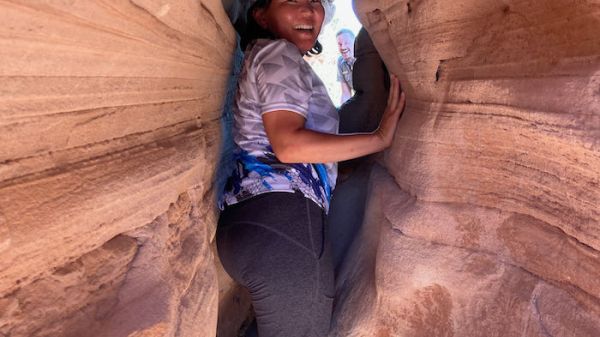A Girl on the Moon: Being an Indigenous Buddhist Baháʼí Educator

Guest blog post written by Irina Ayurzanaeva, an environmental educator from the Lake Baikal region of eastern Siberia. Irina Ayurzanaeva visited Sarah Johnson, founder of Wild Rose Education, in western Colorado through the U.S.-Russian Social Expertise Exchange program of the Eurasia Foundation for two weeks in August and September 2022.
In this guest blog, Irina Ayurzanaeva begins with two stories that weave her Indigenous roots and Buddhist faith. Ayurzanaeva then elaborates on when she first learned about stories through her faith and how stories enhance her work as an environmental educator. The first story is about the girl on the moon, and the second is about Alkhanai National Park.
A Girl on the Moon: Variations of the Indigenous peoples' legend from an anthropologist in Russian.
"Can you see a girl with a yoke on her shoulders?" I asked Sarah Johnson, founder of Wild Rose Education, while looking at a round moon at midnight during our camping in Colorado National Monument.
"What? Where?" wondered Sarah.
"Have you ever seen a moon like a canvas with a girl?"
"No, I haven't."
Then I started to tell an Indigenous story about a poor girl whose image we can see on a round full moon:
A girl from a rural area decided to go to the river and bring some water, but unfortunately, it was a dark night and she had fallen into the river and drowned. So her soul stayed on the moon, reminding us about this young lady.
Another story that impressed Sarah was about a cave in one of the national parks in my home region which is the only national park that has religious significance in Asian Russia. Every year, many pilgrims come to Alkhanai National Park (very significant for Shamans and Buddhists) and do rituals and ceremonies.
In this story, there is a cave-like hole or arch at Alkhanai National Park. Shaman and Buddhist people believe that if you can wiggle and squeeze through the hole, it means that all of your sins are forgiven and you are clean now. There were cases when a fat person managed through this hole while a thin person got stuck there. It is amazing!
Being an Indigenous woman with Buddhist roots, I'm very happy that my mum and elder people from my community shared these stories in my childhood.
Buddhist people believe that everything has a soul. When we hurt animals or plants, we can hurt our close relatives who were reborn as new creatures. I can remember when I was a little girl, I used to smash small insects in our vegetable gardens: mosquitoes, flies, and bugs. Once I killed a small bug and an old neighbor lady told me in a very strict way: "You shouldn't do this because it has a soul too. People should not kill other lives." I was bemused, but I remember those words now. Destroying a plant or an animal is a sin in our belief.
Of course, he who is a real Buddhist does not destroy any animals or plants. In my community, they say that we should take from Mother Nature just the amount which we need. For example, every year our fathers and brothers go to the forest to pick wood for wintertime. They cut trees and bring them on trucks. But in springtime, a lot of families from our community go and plant trees. If you take one tree from nature you should plant ten trees. This Buddhist philosophy helps me to live in harmony with nature.
When I got older, I met Baháʼí Faith which deepens my knowledge of environmental issues. I like this Faith because it gives me perspective on how communities can make changes on a local level. In the Baháʼí Faith, it is said that Nature gives us all we need: food, shelter, and medicine. But humanity doesn't care and consumes a lot and as a result, we have climate change, climate degradation, and other problems. All we need is to keep balance.
In the Buddhist and Baháʼí Faith, there are a lot of stories that can be used in environmental education. I believe that intangible heritage can help preserve tangible cultural and natural heritage sites. Using folk and Indigenous stories in our interpretation of public lands can give bigger ideas to our visitors.
To learn more about this exchange partnership, visit Wild Rose Education to read, "Lakes and Mountains Connect Environmental Educators from Siberia to Colorado."


